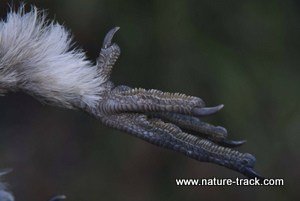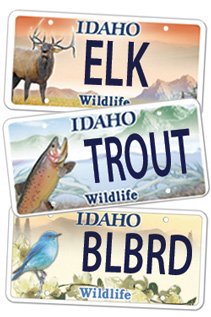Bird Feet

This ruffed grouse foot is well built to withstand cold and to improve floatation over snow.
A friend left a gift for me at work recently: the feet of four different members of the gallinaceous family of birds. There was a ruffed grouse, gray partridge, chukar and ring-necked pheasant. They were all similar with the classic anisodactyl form—three toes in front and one toe behind (the hallux)—but there was divergence too.
Differences in size were immediately noticeable with the pheasant being the largest and the chukar and gray partridge the smallest. The chukar foot was also very red, earning the bird the nickname of Mr. Redlegs.
There were other distinctions as well. The pheasant foot had a sharp conical protrusion, called a spur, about half an inch up from the back toe. This spur, also present on turkeys, can grow to impressive size and is used in fighting for dominance.
Of these four birds, only the ruffed grouse is native. Just from its foot, it was easy to discern that this bird thrives in a habitat far different from that of the non-native species. The foot was feathered all the way down to the toes and the edge of each toe was lined with small papillae that doubled their width and acted like snowshoes. These features are also true of our other native grouse: the blue grouse, sharp-tailed grouse, sage-grouse and spruce grouse. Clearly, these birds are at home in cold snowy country.
Bird feet vary with the different lifestyles of their owners. For water loving birds like ducks, pelicans, gulls and cormorants, the hallux is sometimes reduced or missing and there is a distinct thin membrane forming a webbing between the toes. The webbing may be only between the three main toes or may include the hallux. Webbing may make walking more challenging but dramatically improves the efficiency of their feet when swimming and diving.
Living between open water and land often presents its own set of problems so shorebird feet are adapted differently. Swimming is less important for them as they forage in shallow water or on mudflats. Having a foot that doesn’t sink in the mud is important though and many have just enough webbing to keep them on top of the mud.
The American coot has found a different compromise: its long toes are lobed, but not connected. Other members of the rail family often have extra long slender toes to support them as they walk on top of lily pads and other vegetation.
Raptors, including owls, hawks, ospreys and eagles all use their feet to grasp prey and have the classic anisodactyl formula. However, their strong toes are modified with long talons that pierce and kill their prey.
The second most common foot form is called zygodactyl. This is the form many species that cling to bark use and sports two toes forward and two toes back. This is the foot pattern of woodpeckers and roadrunners.
As I added these specimens to my growing nature collection, I looked at my own size twelves and realized just how boring we humans can be.

Wildlife License Plates
Great news! as of 2024, there are three NEW designs for license plates. They still are bluebird, cutthroat trout and elk, but they are beautiful.
Idaho Wildlife license plates provide essential funding that benefits the great diversity of native plants and wildlife that are not hunted, fished or trapped—over 10,000 species or 98% of Idaho’s species diversity. Game species that share the same habitats (such as elk, deer, antelope, sage-grouse, salmon, trout) also benefit from these specialty plates.
No state tax dollars are provided for wildlife diversity, conservation education and recreation programs. Neither are any revenues from the sale of hunting or fishing licenses spent on nongame species. Instead, these species depend on direct donations, federal grants, fundraising initiatives—and the Idaho Wildlife license plates.
Both my vehicles have Bluebird Plates. I prefer the bluebird because the nongame program gets 70 percent of the money from bluebird plates, but only 60 percent of the money from elk and trout plates - 10 percent of the money from elk plates supports wildlife disease monitoring and testing programs (to benefit the livestock industry) and 10 percent from cutthroat plates supports non-motorized boat access.
Incidentally, in 2014, the Idaho Legislature denied the Department of Fish and Game the ability to add new plates or even to change the name of the elk and cutthroat plates (very specific) to wildlife and fish plates, a move that would have allowed for changing images occasionally and generating more revenue. It would seem that they believe that we Idahoans don't want a well funded wildlife program.
I think it is time we let the Legislature know that Idahoan support wildlife funding and that we would like to see these generic plates come to fruition.
Wildlife License Plates
Great news! as of 2024, there are three NEW designs for license plates. They still are bluebird, cutthroat trout and elk, but they are beautiful.
Idaho Wildlife license plates provide essential funding that benefits the great diversity of native plants and wildlife that are not hunted, fished or trapped—over 10,000 species or 98% of Idaho’s species diversity. Game species that share the same habitats (such as elk, deer, antelope, sage-grouse, salmon, trout) also benefit from these specialty plates.
No state tax dollars are provided for wildlife diversity, conservation education and recreation programs. Neither are any revenues from the sale of hunting or fishing licenses spent on nongame species. Instead, these species depend on direct donations, federal grants, fundraising initiatives—and the Idaho Wildlife license plates.
Both my vehicles have Bluebird Plates. I prefer the bluebird because the nongame program gets 70 percent of the money from bluebird plates, but only 60 percent of the money from elk and trout plates - 10 percent of the money from elk plates supports wildlife disease monitoring and testing programs (to benefit the livestock industry) and 10 percent from cutthroat plates supports non-motorized boat access.
Incidentally, in 2014, the Idaho Legislature denied the Department of Fish and Game the ability to add new plates or even to change the name of the elk and cutthroat plates (very specific) to wildlife and fish plates, a move that would have allowed for changing images occasionally and generating more revenue. It would seem that they believe that we Idahoans don't want a well funded wildlife program.
I think it is time we let the Legislature know that Idahoan support wildlife funding and that we would like to see these generic plates come to fruition.

"WOW. What a phenomenal piece you wrote. You are amazing." Jennifer Jackson
That is embarrassing, but actually a fairly typical response to my nature essays. Since The Best of Nature is created from the very best of 16 years of these nature essays published weekly in the Idaho Falls Post Register (online readership 70,000), it is a fine read. It covers a wide variety of topics including humorous glimpses of nature, philosophy, natural history, and conservation. Readers praise the style, breadth of subject matter and my ability to communicate complex and emotional topics in a relaxed and understandable manner.
Everyone can find something to love in this book. From teenagers to octogenarians, from the coffee shop to the school room, these nature essays are widely read and enjoyed.
Some of the essays here are my personal favorites, others seemed to strike a chord with readers. Most have an important message or lesson that will resonate with you. They are written with a goal to simultaneously entertain and educate about the wonderful workings of nature. Some will make you laugh out loud and others will bring a tear to the eye and warm your heart.
Readers Write:
"You hit a home run with your article on, Big Questions in Nature. It should be required reading for everyone who has lost touch with nature...great job!" Joe Chapman
"We enjoyed your column, Bloom Where Planted. Some of the best writing yet. The Post Register is fortunate to have your weekly columns." Lou Griffin.
To read more and to order a copy, click here or get the Kindle version
Copies are also available at:
Post Register
Island Park Builders Supply (upstairs)
Barnes and Noble in Idaho Falls
Harriman State Park, Island Park
Museum of Idaho
Valley Books, Jackson Wyoming
Avocet Corner Bookstore, Bear River National Wildlife Refuge, Brigham City, Utah
Craters of the Moon National Monument Bookstore, Arco, Idaho